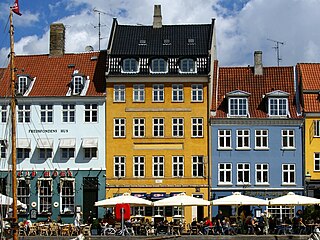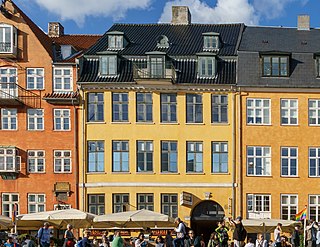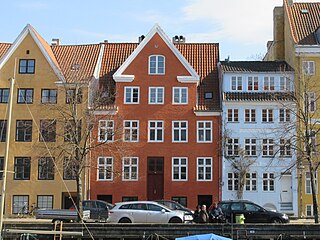
Nyhavn 51 is an 18th-century canal house overlooking the Nyhavn canal in central Copenhagen, Denmark.Above the door is a painted stone relief depicting a lamb. The property was formerly known as Lammet and the sign was used for identification in a time when house numbers had still not been introduced. The letters are the initials of the builder Henrich Lambertsen Engel and his wife Karen Nielsdatter Holm. The building was listed in the Danish registry of protected buildings and places in 1918. It was subject to Schalburgtage during World War II but restored. Notable former residents include the portrait painter Hans Jørgen Hammer, the marine artist Carl Frederik Sørensen and Swedish actress Eva Eklund.

Nyhavn 33 is a listed property overlooking the Nyhavn canal in central Copenhagen, Denmark. A wall stone with a compass rose, a Dannebrog and two sand glasses bears testament to the fact that the building once belonged to a manufacturer of ship sails, flafs and compasses.

The Verrayon House is a Rococo, bourgeoisie townhouse located at Lille Strandstræde 6 in central Copenhagen, Denmark. It was listed by the Danish Heritage Agency in the Danish national registry of protected buildings in 1943.

Nyhavn 67 is a listed property overlooking the Nyhavn Canal in central Copenhagen, Denmark. The writer Hans Christian Andersen lived in the building as a lodger with only short interruptions from 1848 to 1865.

Nyhavn 13 is a historic townhouse overlooking the Nyhavn Canal in central Copenhagen, Denmark. With roots dating back to the late 17th century, it owes its current appearance to a heightening of the building with two floors in 1842. Notable former residents include the businessman Abraham Marcus Hirschsprung and the painter and educator Wilhelm Kyhn. The building was listed in the Danish registry of protected buildings and places in 1945.

Nyhavn 15 is a historic townhouse overlooking the Nyhavn Canal in central Copenhagen, Denmark. The building was listed in the Danish registry of protected buildings and places in 1945.

Nyhavn 23 is a Neoclassical property overlooking the Nyhavn Canal in central Copenhagen, Denmark. It was listed in the Danish registry of protected buildings and places in 1918. A plaque on the facade commemorates the composer Friedrich Kuhlau, who resided there in 1832.

Nyhavn 35 is a historic townhouse overlooking the Nyhavn Canal in central Copenhagen, Denmark. The building was listed in the Danish registry of protected buildings and places in 1945. Notable former residents include the businessman Jørgen Thomsen Bech and the composer Andreas Peter Berggreen.

Nyhavn 41 is a listed property overlooking the Nyhavn canal in central Copenhagen, Denmark. For most of the 19th century, the property was owned by a family of sailmakers. The manufacturing of flags and compasses was also part of their trade. The building was listed in the Danish registry of protected buildings and places in 1918.

Nyhavn 43 is a historic townhouse overlooking the Nyhavn Canal in central Copenhagen, Denmark. The building was listed on the Danish registry of protected buildings and places in 1945. It was refurbished in 1987.

Nyhavn 19 is a property located at the corner of Nyhavn and Lille Strandstræde in central Copenhagen, Denmark. The building was listed on the Danish registry of protected buildings and places.

Nyhavn 27 is an 18th-century property overlooking the Nyhavn Canal in central Copenhagen, Denmark. The building was listed in the Danish registry of protected buildings and places in 1945. In the 18th century, it was for a while owned by the timber merchant Andreas Bodenhoff. The building was later operated as a hotel under the name Stadt Flensburg.

Lille Strandstræde 3 is a Neoclassical property in the Nyhavn Quarter of central Copenhagen, Denmark. The building was listed in the Danish registry of protected buildings and places in 1979.

Nyhavn 37 is an 18th-century property overlooking the Nyhavn Canal in central Copenhagen, Denmark. A distillery was based in a rear wing from a least 1731 until at least the 1860s. The building was heightened with one storey in 1791. The building was listed in the Danish registry of protected buildings and places in 1923.

Overgaden Oven Vandet 24 is an 18th-century property overlooking Christianshavn Canal in the Christianshavn neighborhood of central Copenhagen, Denmark. It was listed in the Danish registry of protected buildings and places in 1945. Notable former residents include the politician Asmund Gleerupl.

Nyhavn 53, also known as Madame Tofte's House, is a residential building overlooking the Nyhavn canal in central Copenhagen, Denmark. It was constructed with three storeys in the 1750s but owes its current appearance to a renovation in the 1870s. It was listed in the Danish registry of protected buildings and places in 1932. Notable former residents include the composer Peter Arnold Heise and the ballet dancer Augusta Nielsen. The Adventurers' Club of Denmark is based in a half-timbered warehouse in the courtyard.

Nyhavn 20 is a 17th-century building overlooking the Nyhavn canal in central Copenhagen, Denmark. It was listed in the Danish registry of protected buildings and places in 1945. The building houses a bar in the basement and a residential apartment on the upper floors. The facade features a relief of a fish above the main entrance, flanked by two reliefs of sailing ships.

Nyhavn 5 is an 18th-century property overlooking the Nyhavn canal in central Copenhagen, Denmark. It was listed in the Danish registry of protected buildings and places in 1945. Notable former residents include the actor Adam Gottlob Gielstrup, opera singer Peter Schram and businessman Cornelius Peter August Koch.

Kvæsthusgade 1/Nyhavn 69 is a three-storey building situated at the corner of Nyhavn and Kvæsthusgade. A memorial featuring a bust of a diver wearing a diving helmet commemorates that Em. Z. Svitzer's Bjernings-Enterprise, a salvage company founded by Emil Zeuthen Svitzer back in 1833, was once headquartered in the building. Notable former residents include the actress Magda von Dolcke.

Nyhavn 57 was a late 17th-century building overlooking the Nyhavn Canal in central Copenhagen, Denmark. The property was listed in the Danish registry of protected buildings and places in 1945. Notable former residents include the artist Heinrich Gustav Ferdinand Holm, Hedeselskabet co-founder Niels Georg Christian Morville and D/S Norden-founder Mads Christian Holm.



























